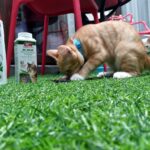Fur shedding in Cats, particularly dogs and cats, is a common natural process in Nairobi that helps them regulate their body temperature and replace old or damaged fur. Shedding is influenced by various factors, including genetics, season, age, health, and breed. Ducknet Veterinary Clinic -Lavington has compiled an explanation of the causes and some prevention strategies for fur shedding in pets:
Causes of Fur Shedding in Cats:
- Breed: The breed of your pet plays a significant role in the amount and frequency of shedding. Some breeds are known for minimal shedding
- Season: Most pets shed their fur seasonally. They develop a thicker coat in the winter to keep warm and shed excess fur in the spring and summer to stay cool.
- Age: Young pets and older pets tend to shed less than animals in their prime years. Puppies and kittens may not shed much baby fur, and older pets may have less robust coat growth.
- Health: A pet’s overall health can affect shedding. Poor nutrition, skin conditions, allergies, and hormonal imbalances can contribute to excessive shedding.
- Stress: Stress or anxiety can lead to increased shedding. Changes in environment, routine, or the presence of other animals can trigger stress-related shedding.
Prevention and Management of Fur Shedding in Cats:
While you can’t entirely prevent shedding in your pets, you can take steps to manage it and minimize the impact on your home:
- Regular Grooming: Regular grooming helps remove loose fur and minimizes shedding around the house. Brush your Cats coat according to their specific needs (long-haired breeds may require daily brushing, while short-haired breeds can be brushed less frequently).
- Proper Nutrition: Feed your pet a balanced diet with high-quality pet food. Omega-3 fatty acids, found in some pet foods and supplements, can help maintain healthy skin and reduce shedding.
- Hydration: Ensure your pet has access to clean water at all times. Proper hydration supports healthy skin and fur.
- Stress Management: Minimize stressors in your pet’s life by maintaining a consistent routine, providing plenty of exercise and mental stimulation, and offering a comfortable and secure living environment.
- Seasonal Adjustments: Be prepared for seasonal shedding changes by increasing grooming during peak shedding seasons and ensuring your pet has appropriate protection from extreme weather conditions.
- Consult a Veterinarian: If you notice excessive or sudden shedding, consult your veterinarian. It could be a sign of underlying health issues such as allergies, parasites, or hormonal imbalances that need to be addressed.
- Vacuum and Clean Regularly: Invest in a good pet hair vacuum and clean your home regularly to manage fur that has already been shed. Wash pet bedding and other fabrics frequently.
- Consider Allergies: If you or a family member have allergies to pet dander, consult an allergist for advice on managing allergies while living with pets.
Remember that shedding is a natural and healthy process for most Cats. While you can reduce the amount of fur in your home through grooming and proper care, it’s essential to balance your pet’s comfort and well-being with your desire for a clean living space.







